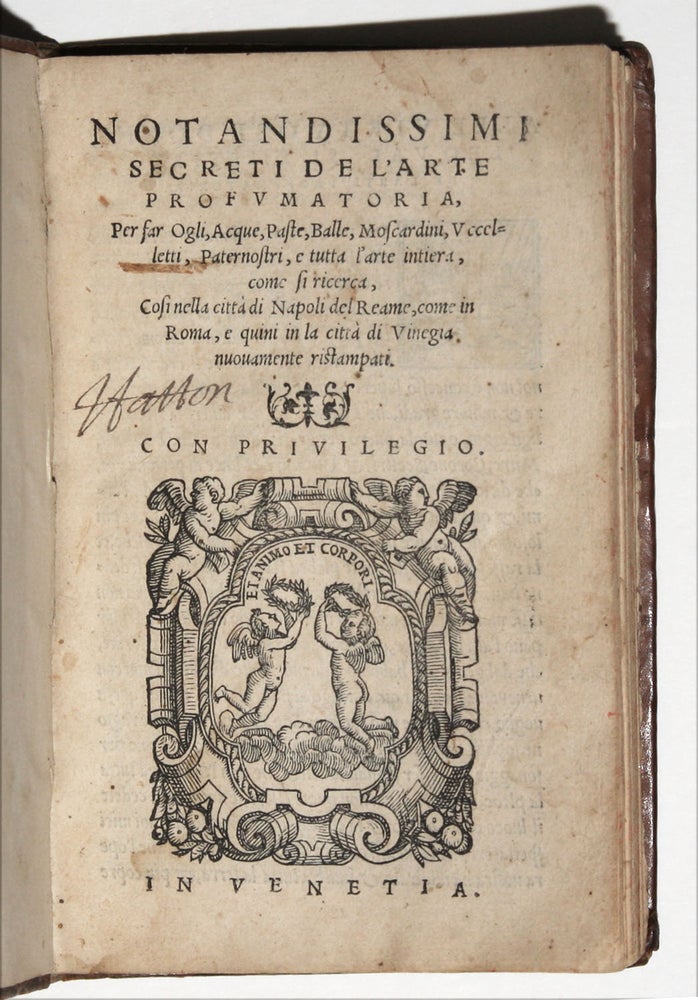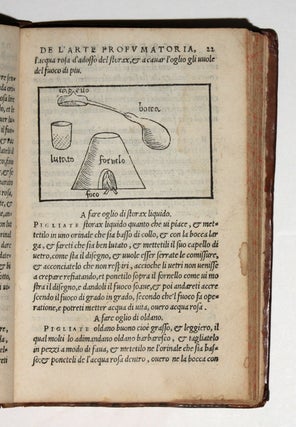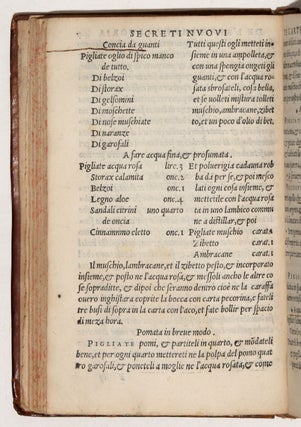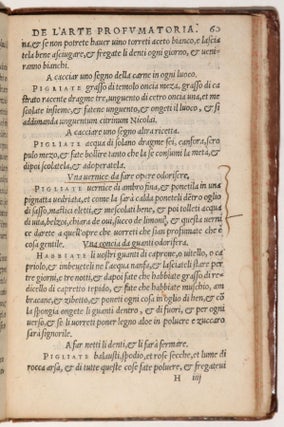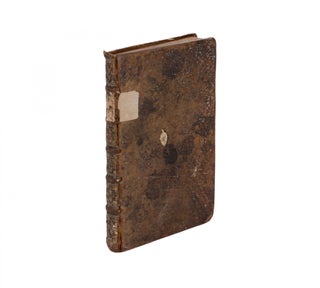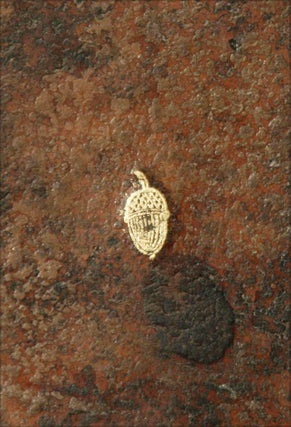Notandissimi secreti de l’arte profumatoria, per far ogli, acque, paste, balle, moscardini, uccelletti, paternostri e tutta l’arte intiera, come si ricerca cosi nella città di Napoli del reame, come in Roma, e quini in la città di Venegia.
8vo [14.5 x 9.5 cm], 74, (6) ff., with three woodcuts in the text showing distillation apparatus. Bound in 17th-century European calf with gilt acorn emblem on boards, spine with gilt ornaments and paper manuscript title label. With copious underlining, manicula, and occasional annotations in an early hand, signed on the title page ‘Hatton’ (possibly Sir Christopher Hatton [1605-70], Member of Parliament and Controller of the Household to the King, exiled in 1648), tear on f. 6, occasional faint waterstaining, otherwise a very good copy. Rare second edition (first 1555) of the first treatise on the art of perfume making, Giovanni Ventura Rossetti’s Notandissimi secreti de l’arte profumatoria, a volume published in Venice and highlighting that city’s central role in the history of the olfactory arts: Venice developed its cosmetological status both through its ready supply of exotics traded from the Middle East and by its seemingly inborn fascination with feminine beauty and allure. Long Europe’s mercantile connection to Constantinople, the Levant, Arabia and beyond, Venice was the portal through which the most important Islamic innovations – be they astronomical, optical, algebraic, or, indeed, cosmetic – traveled westward. Essential ingredients for enhancing beauty, too, had long arrived in Europe through the agency of Venetian traders. Well known, for example, is the Venetian merchant Marco Polo’s 13th-century account of acquiring ambergris – the foundational substance of many fragrances – that had been harvested from whales in the Suqutra Islands, located south of Arabia Felix (present day Yemen). Rossetti opens his work promising to reveal the beauty secrets of women from Venice, Naples, Rome, Florence, Bologna, Milan, Ferrara, Genoa, Lyon and Paris, but he reserves his most effusive praise for the talents of women from “Cairo, Syria, and Egypt, where I find no gentlewoman, lady, or matron – be she an adolescent, of the perfect age, or of more mature years – who does not truly delight in making herself up according to her station and her qualities” (f. 2r). Among the author’s dozens of recipes, formulas, and recommendations can be found many “raw materials” of beauty that carry clear linguistic markers of their Eastern origins: cipri alessandrini, gomma arabica, polvere di rose damaschine, gelsomini arabici, etc. Still more ingredients called for by Rossetti, with such unusual names as belzoino and storax calamita, were known since antiquity to be available only through Eastern trade routes with Arabia, their mysterious origins no doubt enhancing their exotic allure in luxury goods. The “secrets” divulged by Rossetti include, inter alia, precise formulas for perfumes, perfume waters, fragrant lotions, scented soaps, oils both essential and distilled, dyes, incense, rouge or make-up, what we would now call “hair product,” a special “Florentine” soap, a cream to smooth calluses, a sort of tooth-paste, a liquid for lightening the hair and keeping it blond, and salves to whiten the skin. Recipes for sapon damaschino (Damascus soap) remind us of the Syrian soap known today as savon d’Alep, or ghar soap, still a popular regional product (f. 5). Rossetti also supplies recipes for chemical processes to manipulate various materials related to self-adornment: substances to soften crystal and coral, various inks, varnishes, gilding, and so forth. The work also forms part of a mid-16th-century wave of professional books on technology that disclosed what previously were the insider “secrets” of professional guilds (e.g., Birninguccio, Agricola). To this end, and likely to avoid any repercussions from guild members, Rossetti omitted his name from the book’s title page, though he is mentioned as the work’s author on f. 73. Rossetti was also responsible for the first printed text devoted exclusively to dyeing (Plico dell’arte del tengere, Venice, 1548). Little beyond this is known of Rossetti, save that he is documented as being an official at the Venetian Arsenal between 1530 and 1548. With thanks to Professor Mirjam Foot of University College, London, who suggested the ownership attribution of Sir Christopher Hatton. OCLC lists U.S. copies of the present edition at University of Delaware, National Library of Medicine, Hunt Botanical, UCLA, and Yale. For the first edition of 1555: Harvard, National Library of Medicine, Hunt Botanical, Delaware, and University of Maryland. * Adams N353; Sagarin, p. 215; M. Ron, Bibliotheca Tinctoria, p. 338; listed in A. Erdman’s bibliography (“Books on and for Women”) in My Gracious Silence: Women in the Mirror of 16th Century Printing in Western Europe, (Lucerne: Gilhofer & Ranschburg, 1999), p. 189; Notandissimi secreti de l’arte profumatoria: Venezia 1555, Franco Brunello and Franca Facchetti, eds., (Vicenza: N. Pozza, 1973); not in Osler, Waller, or Honeyman.
Price: $14,500.00

